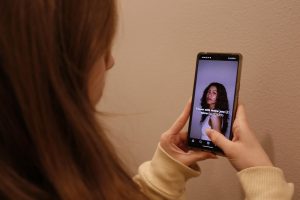Beyond the lab: 6th graders, new teacher reflect on first Lil’ SIS
Photo credit: Emily Paschall
Middle schoolers’ Lil’ SIS projects are displayed on vibrant posters, which are lined up in the library. Archer recently had their 10th annual Lil’ SIS May 10, and sixth graders said they enjoyed learning how to use the scientific method while practicing group work.
May 17, 2023
Entering Archer as a new student or faculty member means being introduced to many school traditions. One tradition all middle school students partake in is the annual Little Science Inquiry Symposium. The 10th annual Lil’ SIS took place in the library and dining hall May 10.
Lil’ SIS is a program incorporated into sixth, seventh and eighth grade science classes. The program requires students to conduct scientific experiments in groups and eventually present their data to a panel of judges, peers and teachers.
Science teaching apprentice Dylan Simon is new to Archer this year and teaches seventh grade Life Science alongside science teacher Jerilyn Neshek. Simon recently experienced her first Lil’ SIS. When she heard about the program, Simon said she was amazed by the opportunity Lil’ SIS gives middle school students to develop their research skills.
“I was just blown away by the opportunities Archer middle schoolers get to do scientific research. A lot of the projects that my students did this year — and that I saw sixth and eighth graders doing — were definitely things I didn’t have the ability or the resources to do until I went to college,” Simon said. “I think it’s really incredible that Archer supports scientific research for students at such a young age, given that most people don’t really conduct their own research until college.”
Sixth grader Elyse Harris said she initially felt nervous when introduced to Lil’ SIS, as she does not feel science is her strongest subject. However, she said the program helped her gain research skills, which will be beneficial for future research projects. For her project, Harris and her group worked on testing different types of water to find out which one would help snap pea plants grow best.
Simon said one of the most prevalent challenges for students in her seventh grade class was choosing a topic to research. Harris agreed, and she described how her group felt behind after not being able to decide on a project. Harris also said persevering through the uncertainty helped her and her group set clearer expectations surrounding communication.
“Thinking about what we were going to do for our project was definitely a struggle. I feel like my group was always behind in what we were supposed to do from the other groups, which was also stressful,” Harris said. “We got better with communication, but towards the beginning, the communication wasn’t that strong of what we wanted each other to do. But, I think we got it together quickly after we made changes.”
Along the journey of developing her experiment, Harris said science teacher Anais Cauich was very supportive and helped her and her group overcome any difficulties they faced.
“[Ms. Cauich] would [take] the time to help me understand all the information I needed to know in more depth, and I really appreciated that,” Harris said. “It helped me a lot.”
Simon said she thinks the challenges students faced in Lil’ SIS developed their collaboration skills and helped them gain more confidence through getting to practice using the scientific method to design their project.
“I think they gain a lot of great group work skills … middle school is a time where it’s crucial for students to work together … I purposely put students with other students that I knew they would work well with, but I really watched their group work and their presentation skills flourish during Lil’ SIS,” Simon said. “They gained the opportunity to practice and go through with the scientific method, which is what we are trying to instill in our young scientists in middle school.”
Sixth grader Jayne Weiss said she enjoyed Lil’ SIS and found it fun to create her own project. She and her group measured pH levels in different water brands to see how that impacted the price of the water. Weiss said she thinks Archer does Lil’ SIS to introduce students to science in an enjoyable way.
“Sometimes, people don’t enjoy science,” Weiss said. “But, this is also a fun way to do it their own way.”
Harris described how Lil’ SIS aligns with Archer’s value of inspiring students to make change. She said she thinks this principle is highlighted through Archer’s incorporation of this program in the middle school science curriculum.
“I feel like Archer’s values make it like you can change the world one day,” Harris said. “With Lil’ SIS, it’s like you can change [the world] through science. I saw some pretty cool science projects that actually could help the world.”









